Some say the most difficult transition of having children is moving from 0 children to 1 child. Some say it is when you move from one to two. Others say adding the 3rd is the most difficult and adding more after that is a piece of cake.
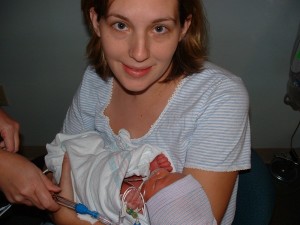 For me, it was transition from 1 to 2 children. We found out we were pregnant with our second child when our first was 7 months old. We were a little shocked since we weren’t exactly planning on having another baby so soon. We call him our “gift we didn’t know to ask for”. They were supposed to be 16 months apart but Isaac (the second) was born 6 weeks early. He spent 2 weeks in the NICU with some minor complications.
For me, it was transition from 1 to 2 children. We found out we were pregnant with our second child when our first was 7 months old. We were a little shocked since we weren’t exactly planning on having another baby so soon. We call him our “gift we didn’t know to ask for”. They were supposed to be 16 months apart but Isaac (the second) was born 6 weeks early. He spent 2 weeks in the NICU with some minor complications.
Having a 14 month old and a preemie was difficult for me. Isaac was very jaundiced when he came home so he slept a lot the first few weeks. After that he became more high needs and needed physical contact almost 24 hours a day. I struggled with feeling guilty that I couldn’t always meet my oldest son’s needs right away. I remember realizing that there were going to be many days that someone would have to wait while I met the other child’s needs–and that often meant that someone would be crying. Due to the circumstances of the children being so close together and one being premature and high needs resulted in some post partum depression. I was sleep deprived, still transitioning to being a stay at home mom, and found parenting to be quite a challenge. Things started to get better when Isaac was 7 or 8 months old.
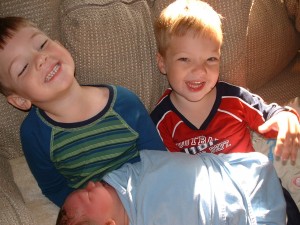
We wanted to give ourselves a break before having another baby. Sometimes my husband would joke about getting pregnant right away again so we could just get it all over with. I think my eyes turned red and tried to shoot lasers at him. It took us a little longer to get pregnant with our third baby and the age gap between #2 and #3 is 35 months. We weren’t sure if #3 would be our last baby and I had the attitude that I would enjoy my third as if it were my last baby. That attitude helped me to enjoy all my kids, and especially my third. It helped me get through all those sleep deprived nights.
I found that adding a third was not as difficult as I thought it would be. Adding a child to a family causes the whole family to transition since everyone’s role changes. Responsibilities change between the parents, the former youngest child is now the middle child (or one of the middle children), the older child gains more responsibility and higher expectations. It is a big shift in a family–unless you are the Duggers–they seem to transition very easily!
Keep in mind this is our experience with going from Man-on-Man parenting to Zone parenting!
Here is what we did that helped us get through those early days of having three kids:
I wore the baby in a sling a LOT. It made life aound the house run so much smoother.
We had meals brought to us by friends and people from our church. We also planned ahead and had some meals in the freezer. Those were all lifesavers!
Both older kids were still napping during the day and went to bed at the same time. Their bedtime routine continued as normal and their dad did all the bedtime stuff while I handled the baby, dinner, and dishes.
The two older boys spent a lot of extra time with daddy while I handled the baby. (i.e. Running errands on a Saturday or Sunday afternoon, making a quick trip to the store after getting home in the evening)
Friends offered to take our oldest to preschool two days a week and we were responsible for the third day. Graham (the third) was born on Labor Day so school for Ewan started two days after. Having friends take Ewan to school and bring him home was super helpful. Carpooling is awesome!
Some challenges and things to be aware of:
We found it difficult to bathe our third child regularly. For so long the older two had bathed together and gone to bed either at the same time or within a half hour of each other that we just couldn’t seem to fit the baby into the bathing schedule. I am so embarrassed to admit this but sometimes I wouldn’t remember when I had last bathed him–we were doing well if he got bathed once a week! I finally figured out that I could bathe the baby in the morning and when the baby was about 4 or 5 months old and have more of a regular bedtime I would just move all the dinner dishes on the counter and bathe the baby in the sink while the older two were getting their baths after dinner.
When our oldest dropped his nap we started letting the middle child nap less. Eventually we dropped his nap for him because it was difficult to juggle three different bedtimes. It was easier to deal with a little extra grumpiness in the afternoon and put both the older boys to bed early at the same time.
Our third child has done a lot of things earlier than our other two did–like eat cookies, ice cream, candy. I am not big into junkfood for the kids but if the baby (who is almost 2) sees his older brothers eating a piece of candy, he wants to do it too. He desperately wants to be a big boy and fit in with his bubbas. I don’t let him get everything he wants by any means, but I am much more relaxed about letting the baby do things than I was with the other two.
My parenting is different with our third than it was with our first. We did a lot of things by trial and error with Ewan and now I am much more comfortable with being a mom. I think I am a better mom than I was when I first started out. I understand more about kids, the ups and downs of different ages, my own limitations, and some things that seemed to be such a big deal aren’t such big deals to me anymore. Being a parent is a lot of on the job training, isn’t it?
My house got messier. Now, I like to think that part of that was because we lived in a 4 story house and it was just hard to keep clean (looking back, I think we just had too much stuff in a 4 story house that was hard to keep clean). My husband said to me one day, “If I come home and the house is a mess but you and the kids are happy–that is fine with me. I’d rather come home to that than have you stressed out all day keeping everything clean all the time and being grumpy when I get home.” There were many days I took his gracious attitude.
Having some special things to look forward to during the week helped me get through the monotony of day to day life with the kids. Living in a state that had a very long winter was difficult so the different activities really helped. I went to a craft group on Monday mornings with some other ladies. Some brought their children and they all played while we crafted and talked. I went to a play group at least once a week. We also joined my husband up at his school for family lunch day once a week. All the kids from the school would run around and play together and it gave me a chance to be involved in the community. I had two things during the week that I did apart from my kids: I went to a Bible study and taught birth classes.
I got over the fear of taking all three kids out at the same time. In order for me to feel like a sane, normal person I have to get out of the house. Sure, it was stressful sometimes and didn’t always feel worthwhile but having all three kids out and about became the norm.
Having two (or more) older children to entertain the baby and play with him can be a lifesaver. There have been many times that the two older boys have played peek-a-boo with Graham while I finished making dinner or lunches. I imagine that if my kids had more spacing between them they could even be more helpful.
The more children you have, the more difficult it is to get one on one time with them. McKenna wrote a great article this week about spending special alone time with your children. It gets more challenging but it is so worth it–and the older the kids get, the more they appreciate it. My 6 and 4 year old always say they love it when it is “just me and mommy” or “just me and daddy”. Admittedly, I struggle with this issue. I worry about my kids not getting enough individual time with us, but I think that overall it is more important for me to engage with them daily with quality time, regardless of who else is around. I read a study that even if parents spend 15 minutes of quality time engaging with their children by getting eye-to-eye and talking or enjoying an activity together it makes a difference in children’s perceptions of feeling loved and cared for.
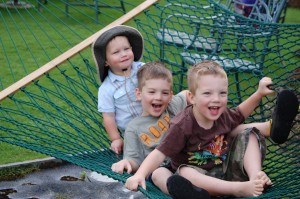
I don’t want this article to sound all doom and gloom–there are definitely challenges and some are quite different depending on the age gap between children. Children are a gift and wonderful to have. For all the challenges that having a child brings, there is 10X more joy that comes with it. My kids bring me delight and we spend a great deal of time laughing together as we celebrate each other and all our family inside jokes.
If you are considering having a third child but don’t know if you can do it, I say GO FOR IT! It can seem so daunting before you get pregnant–or while you are pregnant with your third for that matter–but somehow it works itself out. You find a new family routine, your children adjust, your spouse adjusts, you adjust. It just works–like magic.
Are you considering having a third? What are some of your fears or considerations? If you already have a third (or more) did you have some of the same challenges? Don’t be shy! Tell us your story!
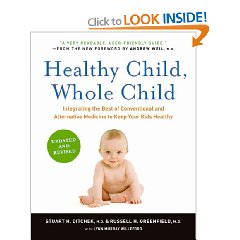

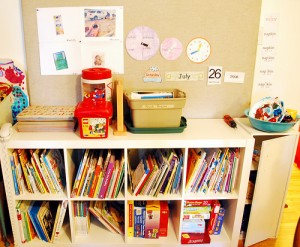
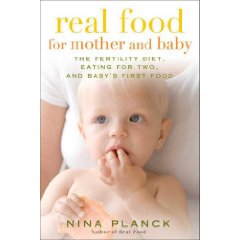 I recently read Nina Planck’s book
I recently read Nina Planck’s book 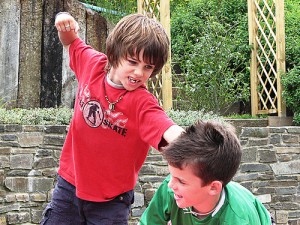 Do you ever think your kids talk too much about fighting or violence? Do your kids wrestle every day? Does it start out fun and then end in tears? I noticed in the past few weeks that my two older boys were wrestling a lot and that the wrestling was turning into frustration and fighting quicker than normal. At first I thought it was an “end of summer cabin fever and we don’t have much of a schedule” thing going on. Then I noticed that my 4 year old was making a lot of references to fighting and it was really bothering me.
Do you ever think your kids talk too much about fighting or violence? Do your kids wrestle every day? Does it start out fun and then end in tears? I noticed in the past few weeks that my two older boys were wrestling a lot and that the wrestling was turning into frustration and fighting quicker than normal. At first I thought it was an “end of summer cabin fever and we don’t have much of a schedule” thing going on. Then I noticed that my 4 year old was making a lot of references to fighting and it was really bothering me. For me, it was transition from 1 to 2 children. We found out we were pregnant with our second child when our first was 7 months old. We were a little shocked since we weren’t exactly planning on having another baby so soon. We call him our “gift we didn’t know to ask for”. They were supposed to be 16 months apart but Isaac (the second) was born 6 weeks early. He spent 2 weeks in the NICU with some minor complications.
For me, it was transition from 1 to 2 children. We found out we were pregnant with our second child when our first was 7 months old. We were a little shocked since we weren’t exactly planning on having another baby so soon. We call him our “gift we didn’t know to ask for”. They were supposed to be 16 months apart but Isaac (the second) was born 6 weeks early. He spent 2 weeks in the NICU with some minor complications.


